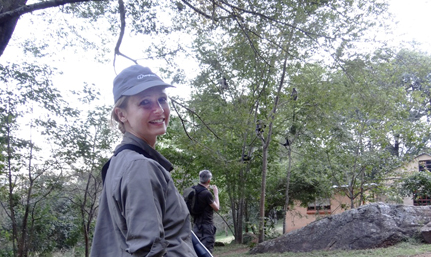|
 |
Dr Kate Nowak in the Soutpansberg Mountain
Photo: Supplied
04 June 2013 |
Have you ever wondered how our wild cousins deal with stress? Dr Kate Nowak, visiting postdoctoral researcher at the Zoology and Entomology Department at the UFS Qwaqwa Campus, has been assigned the task to find out. She is currently conducting research on the effects that stress and fear has on primate cognition.
The Primate and Predator project has been established over the last two years, following Dr Aliza le Roux’s (also at the Zoology and Entomology Department at Qwaqwa) interest in the effects of fear on primate cognition. Dr le Roux collaborates with Dr Russel Hill of Durham University (UK) at the Lajuma Research Centre in Limpopo and Dr Nowak has subsequently been brought in to conduct the study.
Research on humans and captive animals has indicated that stress can powerfully decrease individuals’ cognitive performance. Very little is known about the influence of stress and fear on the cognition of wild animals, though. Dr Nowak will examine the cognition of wild primates during actual risk posed by predators. This is known as the “landscape of fear” in her research.
“I feel very privileged to be living at Lajuma and on top of a mountain in the Soutpansberg Mountain Range. We are surrounded by nature – many different kinds of habitats including a tall mist-belt forest and a variety of wildlife which we see regularly, including samangos, chacma baboons and vervet monkeys, red duiker, rock hyrax, banded mongooses, crowned eagles, crested guinea fowl and cape batis. And of course those we don't see but find signs of, such as leopard, genet, civet and porcupine. Studying the behaviour of wild animals is a very special, and very humbling, experience, reminding us of the diversity of life of which humans are only a very small part,” said Dr Nowak.
At present, the research team is running Giving up Densities (GUD) experiments. This represents the process during which an animal forsakes a patch dense with food to forage at a different spot. The animal faces a trade-off between meeting energy demands and safety – making itself vulnerable to predators such as leopards and eagles. Dr le Roux said that, “researchers from the US and Europe are embracing cognitive ecology, revealing absolutely stunning facts about what animals can and can’t do. Hence, I don’t see why South Africans cannot do the same.”
Dr Nowak received the Claude Leon Fellowship for her project. Her research as a trustee of the foundation will increase the volume and quality of research output at the UFS and enhance the overall culture of research. Her analysis on the effect that stress and fear have on wild primates’ cognition will considerably inform the emerging field of cognitive ecology.
The field of cognitive ecology is relatively new. The term was coined in the 1990s by Les Real to bring together the fields of cognitive science and behavioural ecology.